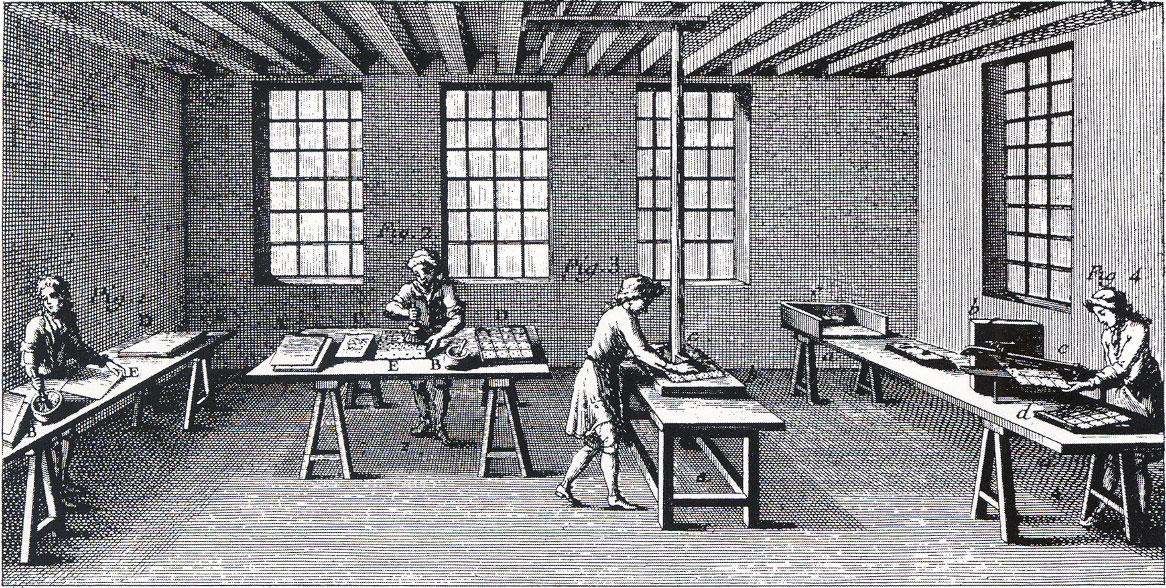Woodblock and Stencil Playing Cards
Around 1987 I decided to make a pack of playing cards from woodblocks and coloured with stencils. I imagined I was carrying out my 'apprenticeship'.
TRADITIONAL ENGLISH PLAYING CARDS
printed from woodblocks
and hand-coloured with stencils

 rom documentary evidence, such as statutes and prohibitions, we get the impression that playing cards were being used in England in the fifteenth century. It is questionable whether these cards were actually made in England from their earliest introduction, so for quite some time they must have been imported. But the 1463 ban on importation leads one to suppose that a domestic industry already existed by this time.
rom documentary evidence, such as statutes and prohibitions, we get the impression that playing cards were being used in England in the fifteenth century. It is questionable whether these cards were actually made in England from their earliest introduction, so for quite some time they must have been imported. But the 1463 ban on importation leads one to suppose that a domestic industry already existed by this time.
Around 1987 I decided to make a pack of playing cards from woodblocks and coloured with stencils. The purpose of the exercise was to acquire insight and practical experience into the circumstantial problems of printing playing cards from woodblocks, their design, colouring with stencils, etc. I was carrying out my 'apprenticeship'.
I acquired the necessary blank wood blocks (lime wood) and had them planed flat and made 'type high'. I then discovered that the woodcutting tools which I had acquired for the task were useless, and so I made my own set out of watchmaker's tools, which are made from higher grade steel.
The Court Cards
The next decision was the model for the court cards. I chose the seventeenth century designs of Hewson, which exemplify the 'English' style which had crystallised by then. Hewson's cards seem very formal and exhibit that geometric construction which characterises the English pattern, as opposed to the earlier cards which had been imported from the continent (by card makers such as Valery Faucil, Pierre Marechal, Jehan Henault, Anthoine Le Cornu, etc.)
Whilst French cards had a tradition of being named after historical personalities, English court cards were never named or based on any historical personalities. The costume worn by the English court pattern came from a French perception of that worn by the monarchy and their attendants, presumably at the time when the designs were first made. This partly explains the strange costumes on the cards, alongside poor copying.
To explain: when copying from an earlier design, or adapting it to a different size or medium, the figures may become 'squeezed' into the desired shape by distorting the limbs, shortening the neck or ankles, and losing the proportions of the original figure, particularly if one is not a very competent artist. We can confirm that English cards are shorter and wider than their French counterparts. Furthermore, when cutting out the designs on the woodblock, perhaps intent on finishing as soon as possible, finer features of the design will be simplified, ignored or removed… in which case the design may become corrupted or modified. English playing cards often look as though this sort of thing has happened. The stencilling is often slap-dash which further obliterates the designs. These reductions in quality are probably due to cost-effectiveness: there is often a sense of expediency. Did this matter?
The English Pattern
Perhaps the problem was compounded in that they weren't always sure exactly what they were representing. It is ironic that embargos had been secured against imported cards, but that home-produced ones were so badly designed! However, due to the formalisation of the designs, and whether they are called 'packs' or 'decks', today the English pattern has become the leading international pattern. The Americans took it with them and perpetuated it over there, although they introduced innovations including the joker and (probably) corner indices►
THE PIP CARDS
There is more to making a pack of playing cards than designing and printing the court cards… namely the pip cards. The stencils were made from heavy, oiled card and the pips were cut with punches which I had specially made. I believe that this is how they were traditionally made, otherwise there would have been noticeable variations between adjacent pips had they been cut out by hand.
With the benefit of hindsight I can now see where I made mistakes, particularly at the colouring stage. It was fascinating to rediscover why the old card makers did things in particular ways, which may appear odd or eccentric until we try to do it differently. Then we see the logic!
The wrappers were printed from woodblocks with letterpress overprinting. The backs were plain white, as they were traditionally.
Alternative Colour Scheme

Above: during the stencilling stage I also tried alternative colour schemes.
See also: Amos Whitney's Factory Inventory Chromolithography Design of Playing Cards Make your own Playing Cards Letterpress Printing Manufacture of Cardboard Manufacture of Playing Cards, 1825 Rotxotxo Workshop Inventories, Barcelona The Art of Stencilling


By Simon Wintle
Member since February 01, 1996
Founder and editor of the World of Playing Cards since 1996. He is a former committee member of the IPCS and was graphics editor of The Playing-Card journal for many years. He has lived at various times in Chile, England and Wales and is currently living in Extremadura, Spain. Simon's first limited edition pack of playing cards was a replica of a seventeenth century traditional English pack, which he produced from woodblocks and stencils.
Related Articles

Victorian grocer’s scale plate
Large flat plate decorated with highly coloured English cards and royal arms.

Queen of Arts
A wide variety of women artists celebrated on cards with illustrations by Laura Callaghan.

The Glasgow Pack
Issued to celebrate Glasgow’s reign as European City of Culture in 1990, with city views and works o...

Cathedrals, Abbeys & Minsters playing cards
54 pictures of different famous cathedrals, abbeys and minsters in England and Wales.

Christmas Carols
Christmas Carols playing cards illustrated by Stuart Dilks

Pam is the Knave of Clubs
Playing cards as metaphors in 18th century art - from fate, chance and social hierarchy t...

Question and Answer Games
A card game called “Impertinent Questions and Pertinent Answers” was launched in the early 1920s by ...

Dr Sacheverell
Dr. Henry Sacheverell's impeachment in 1710 sparked widespread public unrest and political upheaval,...

Leadmill playing cards
Promotional pack for an arts centre in Sheffield with designs by Martin F. Bedford.

Agatha Christie and card games
Agatha Christie uses card-play as a primary focus of a story, and as a way of creating plots and mot...

English Heritage
52 different colour photos of historic sites managed by English Heritage.

The Malt Whiskies of Scotland
Three packs featuring photographs by Duncan McEwan of malt whisky distilleries in Scotland.

Typographic Playing Cards
Typographic Playing Cards designed by Jim Sutherland, c.2010.

76: Transitions: Hunt & Sons
Styles change and technology develops. This means that it's possible to see transition periods in th...

Gibson’s History of England
History without tears for young and old, 1920s.

Simpson (Piccadilly) playing cards
Innovative advertising pack for Simpsons of Piccadilly designed by André François.
Trending Articles
Popular articles from the past 28 days




